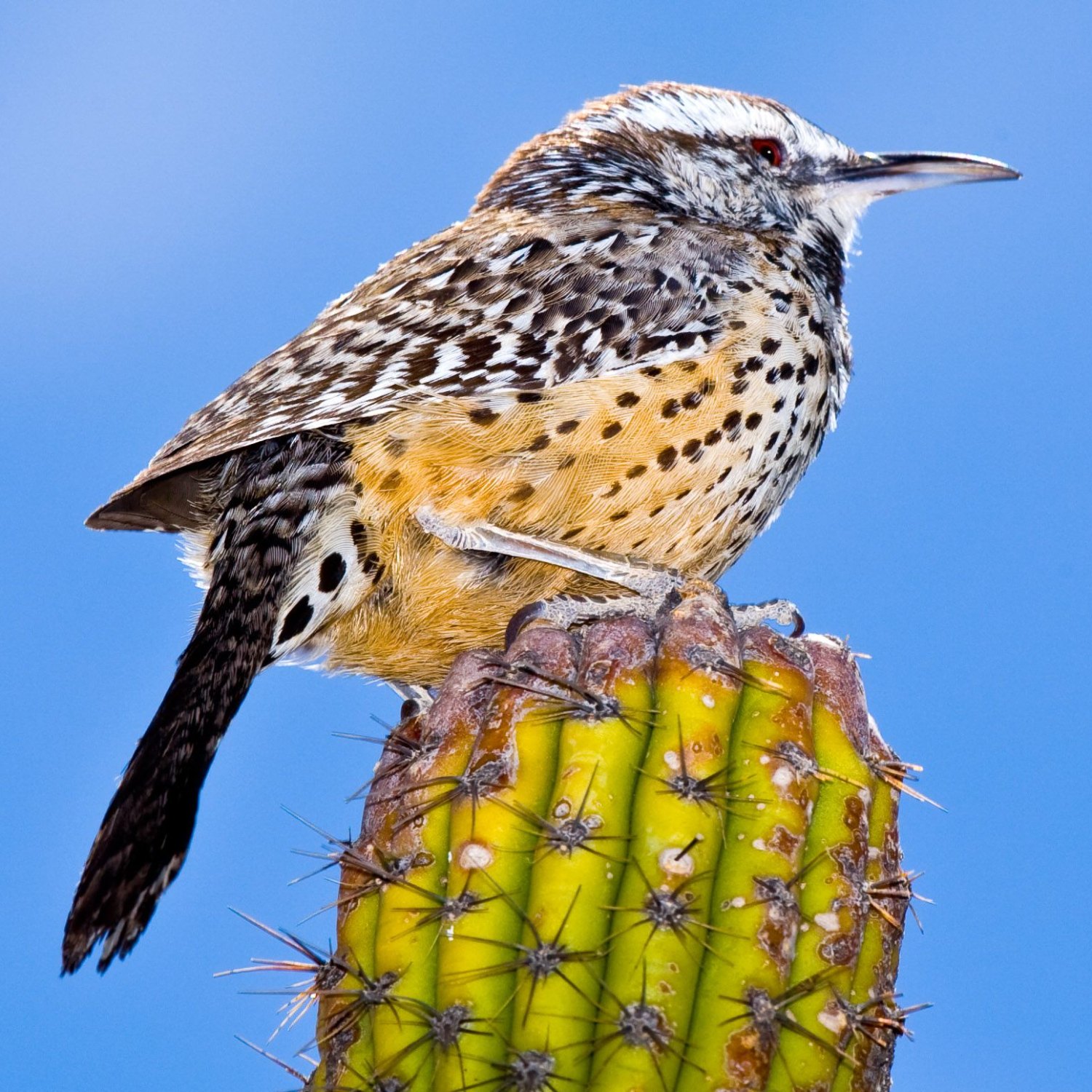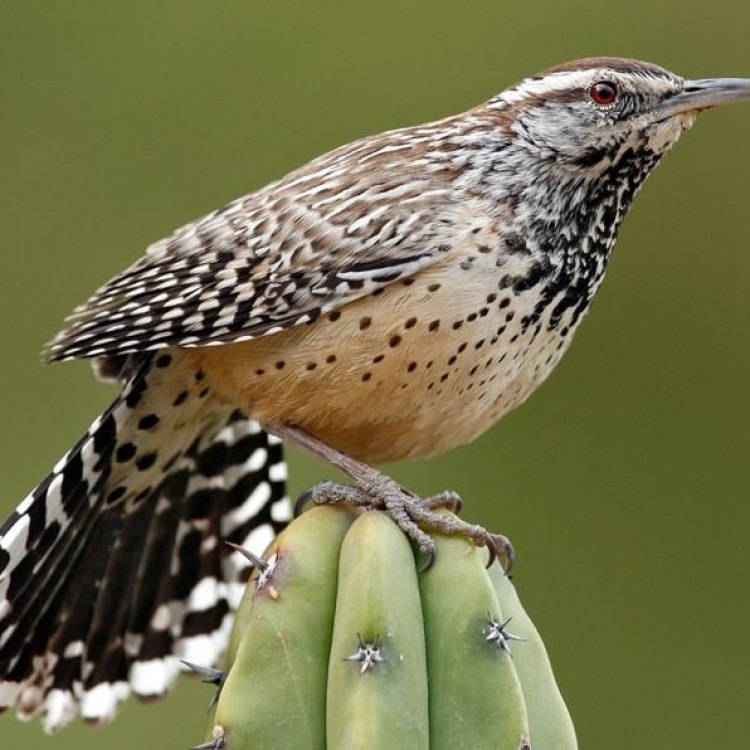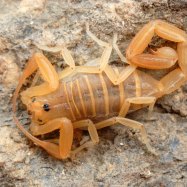
Cactus Wren
7.5-9.1 inches
The Cactus Wren is a charming bird found in the southwestern United States, known for its distinct vocalizations and small compact body shape. These social birds can be spotted in Arizona, New Mexico, Texas, and California, making their homes in cacti and shrubs. Keep an eye out for this beautiful and lively species on your next outdoor adventure! #CactusWren #SouthwestBirds #WildlifeEncounters
Animal Details Summary:
Common Name: Cactus Wren
Kingdom: Animalia
Habitat: Desert scrub, thorny shrubs, cacti
The Fascinating Cactus Wren: Surviving the Harsh Desert Climate
The dry, parched, and barren landscape of the American Southwest may seem like an uninhabitable place for most creatures. But there is one bird that thrives in this harsh environment – the Cactus Wren. This small brown bird, scientific name Campylorhynchus brunneicapillus, commonly known as Cactus Wren, has adapted and evolved to survive in one of the toughest terrains on the planet.But what makes the Cactus Wren so special and what are its unique features that allow it to thrive in such a challenging habitat? Let's take a closer look at this remarkable bird Cactus Wren.
An Overview of the Cactus Wren
The Cactus Wren is a member of the kingdom Animalia, the phylum Chordata, and the class Aves. It belongs to the order Passeriformes, also known as perching birds, and the family Troglodytidae, which includes wrens, thrashers, and gnatcatchers.This species of bird is primarily found in the southwestern United States, including states like Arizona, New Mexico, Texas, and California, as well as in parts of Mexico. It is also the state bird of Arizona.
The Cactus Wren is an omnivorous bird, meaning it consumes both plant and animal matter. Its diet consists of insects, fruits, seeds, and even small reptiles and mammals.
Adaptations for Survival in the Harsh Desert Climate
Being a resident of the desert, the Cactus Wren has evolved a variety of adaptations that help it survive in this challenging environment. These include physical, behavioral, and physiological adaptations.One of the most apparent physical features of the Cactus Wren is its distinct brown and white coloration California Kingsnake. This mottled, well-camouflaged plumage allows it to blend in seamlessly with its surroundings, providing excellent protection from predators. Additionally, its black streaks and spots on its wings and tail help break up its outline, making it even more difficult to spot.
Another notable adaptation of the Cactus Wren is its small and compact body shape. This design helps reduce the bird's surface area, minimizing water loss through evaporation. Its small size also means that it requires less food and water compared to larger birds.
The Cactus Wren's long, curved beak is another valuable adaptation for survival in the desert. The beak is used for probing the nooks and crannies of cacti and other plants to find insects and other food sources. It also helps the bird break open tough cactus fruits to access their juicy insides.
The bird's feet are also specifically adapted for life in the desert. Its long, sharp claws are perfect for gripping onto the spiky cacti and thorny shrubs that dot the landscape. Its strong legs allow it to hop around on the uneven terrain with ease.
Unique Behaviors of the Cactus Wren
Apart from its physical adaptations, the Cactus Wren has many unique behaviors that contribute to its survival in the desert. These fascinating behaviors have been studied and documented by scientists and bird enthusiasts alike.One of the most intriguing behaviors of the Cactus Wren is its habit of building multiple nests. It constructs several nests in its territory, sometimes as many as ten, but only uses one for breeding. The other nests serve as decoys to confuse predators and protect the bird's eggs and young.
Additionally, these birds are known for their impressive singing abilities. They have a complex and melodious song that they use to defend their territory and attract mates. Male Cactus Wrens have been observed singing from the tops of cacti, using the plant's structure to amplify their calls for miles around.
The Role of Cacti and Trees in the Cactus Wren's Habitat
As their name suggests, Cactus Wrens heavily rely on cacti for survival. These birds are often seen foraging and nesting in the sharp, spiny plants. They have also adapted to use the cacti's thorns to their advantage, often building their nests in the protection of these sharp structures.But cacti are not the only crucial plants in the Cactus Wren's habitat. Trees, especially mesquite trees, play a crucial role in their survival as well. These trees provide vital shade and shelter for the birds in the hot desert climate. They also offer a plentiful supply of seeds, fruits, and insects for the Cactus Wrens to feed on.
The Threats Facing the Cactus Wren
While the Cactus Wrens have successfully adapted to survive in the desert, they still face several threats that could potentially endanger their existence. The loss of habitat due to urbanization and land development is a significant issue for these birds. As human populations continue to grow, more and more of the Cactus Wren's natural habitat is being destroyed, leaving them with fewer resources to survive.Another major threat to their survival is climate change. As temperatures rise, the desert becomes even harsher, making it challenging for these birds to find food and water.
Invasive species, such as non-native plants and animals, also pose a threat to the Cactus Wren's habitat. These invaders compete with the birds for resources and can even prey on their eggs and young.
Conservation Efforts for the Cactus Wren
To protect the Cactus Wren and their habitat, various conservation efforts have been implemented in recent years. Organizations like the National Audubon Society and the National Park Service work to preserve and restore the Cactus Wren's habitat and educate the public about their importance.Landscaping with native plants, using bird-friendly windows, and limiting outdoor cats are some of the ways individuals can help protect the Cactus Wren and other desert birds.
The Astonishing Cactus Wren: A Survivor of the Desert
The Cactus Wren is a true survivor, thriving in one of the harshest environments on Earth. Its physical and behavioral adaptations, along with its close relationship with cacti and trees, have allowed it to withstand the challenges of living in the desert.But as the threats to their habitat continue to grow, it is essential for us to take steps to protect these remarkable birds. With careful conservation efforts and individual actions, we can ensure that the Cactus Wren continues to thrive in the Southwest for generations to come.

Cactus Wren
Animal Details Cactus Wren - Scientific Name: Campylorhynchus brunneicapillus
- Category: Animals C
- Scientific Name: Campylorhynchus brunneicapillus
- Common Name: Cactus Wren
- Kingdom: Animalia
- Phylum: Chordata
- Class: Aves
- Order: Passeriformes
- Family: Troglodytidae
- Habitat: Desert scrub, thorny shrubs, cacti
- Feeding Method: Omnivorous
- Geographical Distribution: Southwestern United States, Mexico
- Country of Origin: United States
- Location: Arizona, New Mexico, Texas, California
- Animal Coloration: Brown, white, black
- Body Shape: Small and compact
- Length: 7.5-9.1 inches

Cactus Wren
- Adult Size: Medium
- Average Lifespan: 7-10 years
- Reproduction: Monogamous
- Reproductive Behavior: Builds large nests with multiple chambers
- Sound or Call: Distinct call resembling a series of harsh churrs
- Migration Pattern: Non-migratory
- Social Groups: Solitary or small groups
- Behavior: Territorial and aggressive towards intruders
- Threats: Habitat loss, predation by snakes and mammals
- Conservation Status: Least Concern
- Impact on Ecosystem: Important pollinators and seed dispersers
- Human Use: Popular species for birdwatching
- Distinctive Features: Long curved bill, bold white eyestripe
- Interesting Facts: Cactus Wrens are known for building multiple dummy nests to confuse predators
- Predator: Snakes, mammals

Campylorhynchus brunneicapillus
The Fascinating World of the Cactus Wren: Nature's Desert Architect
The dry and arid deserts of the Southwest United States may seem like a harsh and unforgiving environment, but amidst the prickly cacti and harsh heat, there is a unique bird species that thrives - the Cactus Wren. With its striking appearance and fascinating behavior, this medium-sized bird has captured the hearts of birdwatchers and researchers alike. In this article, we will delve into the world of the Cactus Wren, exploring its physical characteristics, behavior, threats, and importance in the ecosystem.Native to the deserts of the southwestern United States and northern Mexico, the Cactus Wren (Campylorhynchus brunneicapillus) is a medium-sized songbird measuring around 7-9 inches in length and weighing between 33-49 grams PeaceOfAnimals.Com. Its distinctive features include a long, curved bill, bold white eyestripe, and a speckled brown and white plumage, making it easily recognizable in its natural habitat.
The average lifespan of a Cactus Wren is 7-10 years, and during this time, they are monogamous, forming lifelong pair bonds. This means that they will have a single partner throughout their reproductive years, and the pair will work together to build and defend their territory.
Speaking of reproduction, the Cactus Wren's nesting behavior is quite remarkable. During the breeding season, which typically occurs from March to June, these birds will build large nests with multiple compartments using materials such as twigs, grass, feathers, and spider webs. These nests can reach up to 2 feet in diameter and can have up to 8 entrances.
But what is even more intriguing is that Cactus Wrens are known for building multiple dummy nests to confuse predators. These decoy nests are strategically placed around the territory, making it difficult for predators to determine which one is the real nest. This behavior is crucial for the survival of their offspring, as they face many threats in their harsh desert environment Caribou.
Speaking of threats, the Cactus Wren's survival is constantly under pressure due to habitat loss and human development. As desert landscapes are being destroyed to make way for urbanization and agriculture, the Cactus Wren's natural habitat is shrinking. This not only affects their ability to find suitable nesting sites, but it also limits their access to essential resources such as food and water.
In addition to human-caused threats, Cactus Wrens also face predation from snakes and mammals. Due to their ground-dwelling nature, they are vulnerable to attacks from snakes, while larger mammals such as coyotes, foxes, and bobcats may prey on their eggs and chicks. This makes the Cactus Wren's role as a top predator in the desert ecosystem even more crucial in maintaining a balance in prey populations.
Despite these challenges, the Cactus Wren's conservation status is currently listed as Least Concern by the International Union for Conservation of Nature (IUCN). This means that their population is stable, and they are not at significant risk of extinction. However, conservation efforts are still necessary to protect their habitats and ensure their continued survival.
One of the most remarkable aspects of the Cactus Wren is its impact on the desert ecosystem. As they forage for insects, fruits, and nectar, they play an important role in pollination and seed dispersal. By carrying pollen and seeds from one plant to another, they contribute to the growth and diversity of desert vegetation. This, in turn, provides food and resources for other animals, creating a ripple effect throughout the ecosystem.
Additionally, Cactus Wrens are known to build their nests in the hollowed-out holes of saguaro cacti. These holes are typically created by woodpeckers or other birds, making them prime real estate for nesting birds. By utilizing these cavities, Cactus Wrens provide a service to other species as well by extending the life of a saguaro cactus, as these holes can hold water and provide shelter for a variety of desert animals.
Aside from their important ecological role, Cactus Wrens are also popular among birdwatchers. With their distinct appearance and vocalizations, they are a highly sought-after species for birdwatching enthusiasts. In fact, they are one of the most commonly observed and photographed birds in the Sonoran Desert.
So, what makes the Cactus Wren's call so distinct? Their call has been described as a series of harsh, metallic churrs, often repeated several times in succession. This sound can be heard echoing throughout the desert, especially during the breeding season when males use it to establish their territory and attract a mate.
Despite their solitary and territorial nature, Cactus Wrens can also form small groups, especially during the non-breeding season. These groups can consist of family members or unrelated individuals and are thought to provide safety in numbers against predators.
However, within their own territory, Cactus Wrens are fiercely territorial and will aggressively defend it against any intruders. This behavior is most evident during the breeding season when they must protect their young and resources from competing birds and other animals. In fact, their Latin name, Campylorhynchus brunneicapillus, directly translates to "brown-hooded curved-billed wrestler," referencing their territorial and combative nature.
As we have explored, Cactus Wrens are truly remarkable birds, with their distinct appearance, fascinating nesting habits, and vital role in the desert ecosystem. Despite the challenges they face, these resilient birds continue to thrive and bring life to the dry and arid landscapes they call home.
In conclusion, the Cactus Wren is nature's desert architect, building elaborate nests and contributing to the delicate balance of the desert ecosystem. As humans continue to encroach on their habitat, it is crucial that we work towards preserving and protecting these unique birds and their desert home. Whether you are an avid birdwatcher, a nature enthusiast, or simply appreciate the wonders of the natural world, the Cactus Wren is a species worth admiring and protecting.

The Fascinating Cactus Wren: Surviving the Harsh Desert Climate
Disclaimer: The content provided is for informational purposes only. We cannot guarantee the accuracy of the information on this page 100%. All information provided here may change without prior notice.












